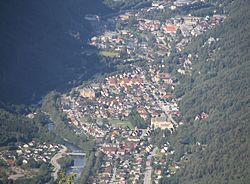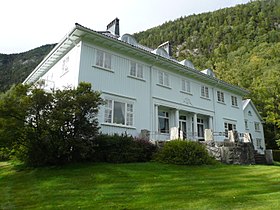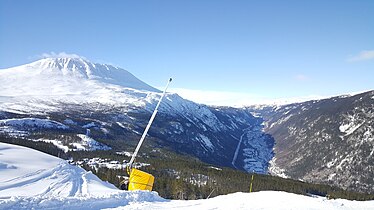Rjukan
Rjukan | |
|---|---|
 View of the town | |
| Coordinates:59°52′44″N8°35′39″E/ 59.87891°N 8.59411°E | |
| Country | Norway |
| Region | Eastern Norway |
| County | Telemark |
| District | Aust-Telemark |
| Municipality | Tinn Municipality |
| Established as | |
| Town(By) | 1996 |
| Area | |
| • Total | 2.59 km2(1.00 sq mi) |
| Elevation | 300 m (1,000 ft) |
| Population (2022)[2] | |
| • Total | 3,003 |
| • Density | 1,160/km2(3,000/sq mi) |
| Time zone | UTC+01:00(CET) |
| • Summer (DST) | UTC+02:00(CEST) |
| Post Code | 3660 Rjukan |
Rjukan(Norwegian:[ˈrʉ̀ːkɑn]) is atowninTinn MunicipalityinTelemarkcounty,Norway.The town is also theadministrative centreof Tinn Municipality. The town is located in theVestfjorddalenvalley, between the lakesMøsvatnandTinnsjå.The municipal council of Tinn declaredtown statusfor Rjukan in 1996. The town is located about 10 kilometres (6.2 mi) to the west of the village ofMilandand about 20 kilometres (12 mi) to the northwest of the village ofTuddal(inHjartdal Municipality).[4]
The 2.59-square-kilometre (640-acre) town has a population (2021) of 3,003 and apopulation densityof 1,160 inhabitants per square kilometre (3,000/sq mi).[2]
The town was essentially "built from scratch" due to the industrial developments byNorsk Hydroin the 1910s and 1920s. It got its name from theRjukan Fallswest of the town. At its peak, Rjukan was a significant industrial center in Telemark. It became aWorld Heritage Siteunder the nameRjukan–Notodden Industrial Heritage Siteon 5 July 2015.[5]The town is perhaps best known for theheavy water sabotageoperations at the localVemorkhydroelectric power plant duringWorld War II.[6]
Rjukan does not get any sunlight between September and March because the low sun is blocked by the tallGaustatoppenmountain located directly to the south.[7]In 2013, at a cost of 5 millionkr,an art project called theSunmirror in Rjukanbuilt several large mirrors on the northern mountainside above the town to reflect the Sun down into the town during these dark months. The mirrors illuminate a small portion of the town square each day.[8]
History
[edit]
In 1906, the area which would become Rjukan consisted of only a few farmsteads, then called Saaheim, whenNorsk Hydrobegan planningsaltpeter(fertilizer) production in the area using the newly developedBirkeland–Eyde process.[4][9]Rjukan was chosen because theRjukan Falls,with a 104-metre (341 ft) longest single fall, provided easy means of generating the large amounts of electricity that was required.
TheVemork hydroelectric power plantwas built between 1907 and 1911, and was at the time the world's largest hydroelectric power plant. A similar power plant was finished inSåheimin 1915. The power plants had a combined cost of more than 200 millionkr,the equivalent of two annual national budgets at the time.[10]With the factories, many houses for the factory workers also had to be built, in addition to a train station and a town hall. The town formally changed its name to Rjukan, and in 1920 reached a population of 8,350.[4]
In 1934, Norsk Hydro built ahydrogenplant next to the Vemork power plant. A by-product ofhydrogen productionvia waterelectrolysiswasheavy water.It was the laterNobel prizewinnerOdd Hasselwho toldNorsk Hydrothat they were in fact in possession of the only regular heavy water production in Europe. At the time heavy water was believed to be a necessary component of anatomic bomb.When Norway came underGerman occupationduringWorld War II,destroying this production became an important priority to the Allies. The facilities weresabotaged twiceby theNorwegian resistance movementand bombed by allied forces.[11]
After 1960, most of Norsk Hydro's saltpeter production in Rjukan was transferred to factories atHerøyainPorsgrunn.
Rjukan Church
[edit]
Rjukan Church was constructed of natural stone with a tower at the entrance to the southwest. The church was consecrated on 21 December 1915. The church was designed by the architects Carl and Jørgen Berner with a cruciform architectural floorplan. The altar image came into place in April 1917 and was painted byBernhard Folkestad.[12]Seven vaulted windows in the foundation wall have stained glass paintings by Torvald Moseid.[13]In February 1965, while filmingHeroes of Telemark,the gallery caught fire, and all combustible material in the church burnt down; only the walls remained. Asbjørn Stein was commissioned as the architect for the reconstruction. The tower was severely heat damaged and had to be largely rebuilt. Most of the walls were reused, and the church basically got the same exterior, but the interior was quite different. The church was ready in 1968 (consecrated on 28 April).[14][15][16]
Tourism
[edit]Rjukan has a long history of tourism, beginning in the 19th century, then mostly focused on the Rjukan Falls. Later, the local resistance fighter and mountain guideClaus Helbergcalled Rjukan "the cradle of tourism in Norway."[17]
In 1811, royal geologistJens Esmark"discovered" the Rjukan Falls, and enthusiastically reported to theDano–NorwegianKing Frederik VIthat he had found "the tallest of all known waterfalls, not just in Europe, but the whole world," which was completely wrong. Apparently, his assistant wrongly measured the total fall at 271 metres (889 ft) tall. In reality, it has a total fall of 238 metres (781 ft), with a largest single fall of 104 metres (341 ft).Skorga,the tallest waterfall in Norway and the sixth tallest in the world, has a total fall of 875 metres (2,871 ft).
Nonetheless, the valley became a famous tourist sight for the European upper classes. During the 19th century, two inns served Norwegian and international guests. One of these guests was French authorJules Verne,who stayed in Rjukan in 1861 during his travels through Norway. During this time he wroteThe Lottery Ticket,an adventure novel set in Telemark. In the novel, he describes the Rjukan Falls as "one of the most spectacular waterfalls in Europe."
In addition to the waterfall, Rjukan had good terrain for skiing, and was a good starting point forhikingon theHardangerviddaplateau andGaustatoppen.
In 1968, Krokan by the Rjukan waterfall became theNorwegian Trekking Association's (DNT) first cabin. After the waterfall was harnessed for hydropower production, the hut was sold. Today it is re-opened and a part of the Unesco World Heritage site, situated by the main road from Rjukan (Tinn) toVinje.
Today, tourism to Rjukan is focused on hiking opportunities, the localGaustablikkski resort (one of the largest in Norway), and theNorwegian Industrial Workers Museumat Vemork. It is also considered one of the bestice climbingareas in Northern Europe because of the large number of waterfalls, and because the lack of sun gives ice consistently.[18]
Notable people
[edit]Gallery
[edit]-
Rjukan town center, narrowly sandwiched between tall, steep slopes
-
Map showing the position of Rjukan between lakes Møsvatn (west, upstream) and Lake Tinn (east)
-
Norsk Hydro Administration Building
-
Rjukan is in constant shadow during the winter. Image taken from Gausta ski center.
See also
[edit]References
[edit]- ^In the Norwegian language, the wordbycan be translated as "town" or "city".
- ^abcStatistisk sentralbyrå(1 January 2021)."Urban settlements. Population and area, by municipality".
- ^"Rjukan, Tinn".yr.no.Retrieved20 August2023.
- ^abcThorsnæs, Geir; Lundbo, Sten, eds. (1 August 2023)."Rjukan".Store norske leksikon(in Norwegian).Kunnskapsforlaget.Retrieved20 August2023.
- ^"Rjukan-Notodden Industrial Heritage Site".UNESCO World Heritage Centre.Retrieved22 July2023.
- ^Kraglund, Ivar; Kjølås, Harald; Allkunne; Færøy, Frode (25 January 2023),"tungtvannsaksjonene",Store norske leksikon(in Norwegian),retrieved22 July2023
- ^Henley, Jon (6 November 2013)."Rjukan sun: the Norwegian town that does it with mirrors".The Guardian.ISSN0261-3077.Retrieved22 July2023.
- ^Alexander, Harriet (23 October 2013)."Norwegian town places mirrors on hillsides to shine light into valley".The Daily Telegraph.Retrieved24 October2013.
- ^Pedersen, Bjørn (12 January 2023),"Birkeland-Eydes metode",Store norske leksikon(in Norwegian),retrieved22 July2023
- ^Brekke, Pål (13 January 2022).Historien om Kristian Birkeland(in Norwegian). Solarmax. pp. 56–60.ISBN9788269131956.
- ^Kraglund, Ivar; Kjølås, Harald; Allkunne; Færøy, Frode (25 January 2023),"tungtvannsaksjonene",Store norske leksikon(in Norwegian),retrieved22 July2023
- ^Henning Alsvik (20 February 2017)."Bernhard Folkestad".Norsk kunstnerleksikon.Retrieved1 December2017.
- ^Sigrid Christie (20 February 2017)."Torvald Moseid".Norsk kunstnerleksikon.Retrieved1 December2017.
- ^"Rjukan kirke".Norske Kirkebygg. Archived fromthe originalon 19 April 2019.Retrieved1 December2017.
- ^Trond Marinus Indahl (20 February 2017)."Carl Berner".Norsk kunstnerleksikon.Retrieved1 December2017.
- ^Anne-Berit Skaug."Jørgen Berner".Norsk kunstnerleksikon.Retrieved1 December2017.
- ^"Rjukan - Notodden på UNESCOs verdensarvliste - Andre attraksjoner in Rjukan, Tinn".Visit Rjukan(in Norwegian Bokmål).Retrieved22 July2023.
- ^"Ice Climbing".Rjukan.Retrieved22 July2023.
External links
[edit]| External videos | |
|---|---|
- Rjukan lag of Norwegian search and rescue dogs
- Ice climbing in Rjukan
- Postcard from Tinn
- Postmarks/cancels from Tinn
- Climbing, mountain bike and skiing in RjukanArchived24 July 2011 at theWayback Machine







